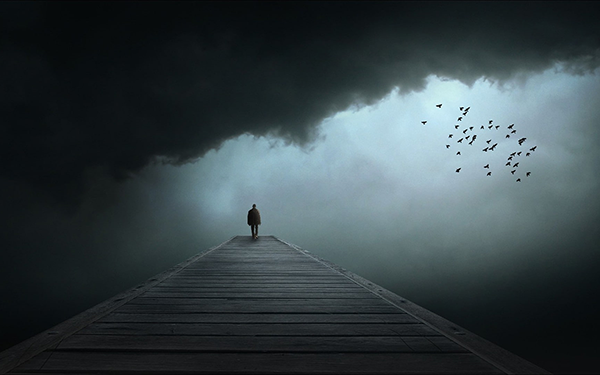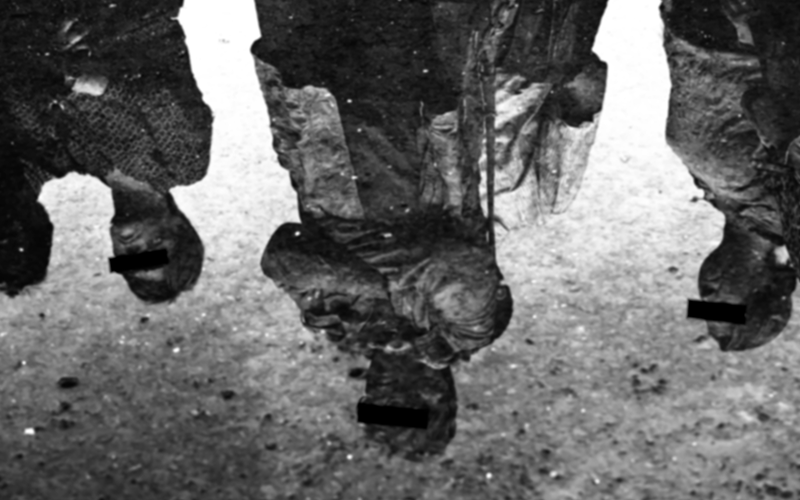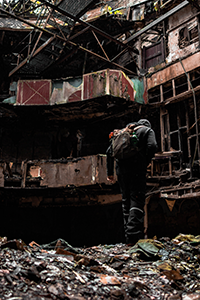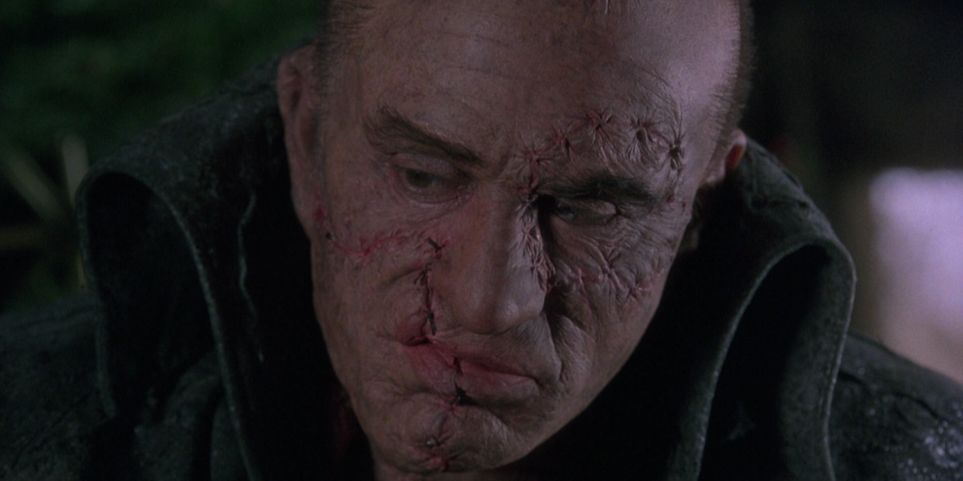by Arthur Paul Patterson
VIRTUE IS FOUND at the margins of society more often than at its centre. If this is so, Mary Shelley's Monster is a real find! Her creature is an isolate of great sensitivity, kindness, and insight. Contrary to James Whale's 1931 film of the Creature as a lumbering dolt, Mary Shelley's Monster was modeled on Rousseau's notion of humanity as the "noble savage." The nobility of the Creature is evident as he unveils his chronicle to Victor Frankenstein upon the icy crags of Mount Blanc.

image by wallpaper flare.com
Meet Frankenstein’s Creature
An aesthete, the Creature responded to nature with appreciation and joy. With the eye of a scientist, he gradually differentiated one object from another. He observed, experimented and made use of the benefits of the created order. This contemplative naturalist distinguished the call of each bird species and attempted to imitate their song with his rough voice.
Like a newborn experiencing the jolt of being, he painfully adjusted to harsh light and sound, quickly learning the lesson that perception and consciousness hurt. Shying away from the glare of sunlight, the Monster was cradled by the moon's subtle radiance. The gentler orb provided a patron, a companion, and a source of spiritual awe. Loneliness insisted that he personify the moon as a special sponsor, but the moon's accompaniment was too subtle for the nurturing of the Creature. His craving for relationship was heartfelt and intense. While his creator, Victor Frankenstein, shrouded himself in secrecy to avoid his fellow scientists, family and friends, the Monster drifted toward civilization to find comfort and fellow-feeling. However much he wanted to have and to be a friend, community was unimaginable. His hideous disfigurement obliged the Monster to live as a clandestine observer of humanity.
The De Laceys, a family in exile, became his model of human culture. These marginals unsuspectingly mentor the Monster. They had withdrawn from the heart of urban Paris to a rustic German village for political and legal reasons. Their suffering and isolation evoked their sensitivity and humaneness. Their virtue was found at the margin, in extremity. In them the Creature had the model and the location to grow toward maturity.
The Outcast's emotions stirred while scrutinizing family life. He admired his human exemplars for their deep love of one another and their sacrifice in times of poverty. He felt their joy when they were hopeful and their sadness when in despair. The Creature's tender conscience surfaced when he discovered that his pilfering intensified their distress. Altering his behaviour, he became their "Good Spirit," doing menial tasks incognito, releasing them for other occupations. Later, he discerned that their experiences of injustice, at the hands of Parisian law, as well as their betrayal by Safie's Muslim father, were sources of extreme torment. It dawned upon him that injustice and betrayal played a significant role in his own wretched condition.
The De Laceys shared the physical burdens of their exile, but more than that, they formed a community of language who encouraged and supported each other. The Creature noticed that language seemed to be a tool for the alleviation of pain and the increase of pleasure. Mastery of the "godlike" science of words might break his lonely quarantine.
The arrival of Safie, Felix De Lacey's Arabian fiancée, expedited the Creature's goal. She had to learn French in order to fully participate in family life. From behind a chink in the rough wall, the Creature took part in a hidden tutorial, learning his lessons more eagerly than the newcomer.
The Creature as Student
An astute and motivated student, he grasped reading well enough to fathom the classics of the Enlightenment. His reading encompassed the cultural, personal, and metaphysical domains of Enlightenment thought. Volney's history, Ruins of Empires, narrated the plight of the exploited "savage" in North America. Hearing of their misery moved the Brute to tears. He compared his rejection by humans with the racial bigotry of the colonizers. Contrasting this history with the hospitality he observed in the little cottage gave him hope. The De Laceys never turned a stranger away from their door. Perhaps they would welcome the strangest stranger of all.
Goethe's Sorrows of Werther introduced the Monster to the sensitivity and agonies of romance. He wept again, feeling kinship with the unrequited Werther. Felix and Safie's affection for one another tore the heart out of the lonesome peeping-tom. He was just becoming aware of his own need for never-to-be granted sexual satisfaction. Self-destruction proposed a decisive way out of pain and rejection. Living, however, seemed to offer more to the Creature since Werther's wretched life displayed a depth of devotion that went beyond mere escape. Sorrow might ennoble the Creature, fitting him for respect if not love.
Plutarch's Lives initiated the Creature to the heroic past of humanity and drew his attention to such things as cities, cultures, wars and lawmaking. The Monster's capacity to appreciate ambiguity in the human condition increased when he read of noble acts followed by brutality and selfishness. Reading Milton's Paradise Lost schooled the Creature concerning humanity's alienation from their Creator. It touched him deeply to learn that while God was at war with his creatures, God also went to great lengths to restore that relationship.
Longing for Relationship

image by Wallpaperflare.com
He wondered if he was worthy of redemption. Exposure to these ideas enabled the Creature to pose the quintessential questions of spirituality: "What did this mean? Who was I? What was I? From whence did I come? What was my destination?"
Learning language incited great thoughts in him but did not satisfy his longing for companionship. His insights and physical existence were kept to himself. Expressing his intuitions and yearnings in the context of acceptance was needed to allow the "godlike" science to dissolve his anguish. Huddled in the cold outside of community, the Creature's newly acquired gift of knowledge served only to deepen his sorrow.
In the ice-cave of Mount Blanc, Victor Frankenstein is compelled to admit that the Monster's "tale and feelings, proved him to be a creature of fine sensation." Relief, however, would only come through relationships. Could the Creature risk rejection? Life at the margin had brought out what was potentially virtuous within him. Would it gain him acceptance?
Neither sensitivity, intelligence nor his pathetic longing for community would overcome human revulsion toward the marred creature.
Had his passionate qualities convinced Victor Frankenstein or the De Lacey family to validate him, Mary Shelley's tale would be a romantic comedy, resembling Mel Brook's modern parody Young Frankenstein (1974). As it stands, the story is a cataclysmic horror tale of compulsion, murder and revenge.
Victor's cruel phrase, "There can be no community between you and me; we are enemies" not only unveils animus toward his progeny but speaks of humanity's collective rejection. The phrase easily translates into "you are outside of human community, we want no part of you." But why? The origins of the Monster, born of the lust of his creator's overreaching schemes, have implied to some interpreters that there is an intrinsic reason for humanity's rejection of him. Physically, he consisted of a tangled mass of dead body parts stitched together to become what nature would never have produced. This quality is labelled by horror philosopher Noel Carrol as "ontological impropriety." The perennial taboo of not blending categories between living and dead, animate and inanimate sets an absolute boundary between the dead and the living. This boundary has been overstepped by Victor Frankenstein; the Monster is the consequence of transgressing nature. From the Monster's perspective this explanation is capricious and unjust: "You are what you are for reasons beyond yourself. You are damned by the human race for it."
Justifying the inhumane treatment of the Monster on physical grounds might have been comprehensible in Mary Shelley's time. Today, when living individuals have the transplanted kidneys, lungs and hearts of the departed sustaining them, this position is nonsensical. Scientifically, we have obscured the boundary between the living and dead; humans have found it to be a boon not a curse. If the Monster is to be found wanting, it can not be on the basis of physiognomy but on a more crucial criterion. A patient combining the parts of other humans or other living beings is no longer considered a monster.
Perhaps it is not Frankenstein's Monster but our species that is incapable of relationship. The problem may be humanity's inability to overcome insularity. Our species is seduced by sameness whether racial, religious, or economic. The Monster is not only dissimilar but is beyond categorization, parent-less, racially indistinct, and vocation-less. Without the ability to link him to anything familiar, those who met the Creature relied on their senses. His physical loathsomeness caricatured humanity. Even so, unknown to those with mere surface sight, the Monster possessed potentials for deep-rooted spiritual and intellectual values. They saw a parody of human nature, not latent humanity.
There was one transitory exception to this stubborn rule, the blind Father De Lacey. The Monster realized his chance for friendship relied more on hearing than sight. Over the months, he observed the elderly De Lacey and found him full of charity, character and the ability to listen. The old man's blindness would surely overcome human prejudice against physical ugliness.
Initially the Creature was correct. De Lacey commiserated with the Monster and graciously offered him help and friendship. The elderly gentleman concluded that his visitor was an honest person in a dire situation of friendlessness. Trust was short-lived, however, owing to the reaction of the old man's sighted family who upon seeing the Monster desperately clinging to their father deemed him a fiendish threat. The prejudice of sight prevailed. Upon the heels of promised friendship, the Creature found himself driven out of the society of the cottagers. Alienation produced rageful violence.

Image by Kieron Mannix
From now on rage carved a swath of misery through the lives of those in the path of the Monster. Anger blinded the wretch morally, leading him to criminality. He plotted to abduct a child whom he imagined was not perverted by human prejudice. Could he train a child to love him? When the child showed his repulsion and declared himself William Frankenstein, younger brother of Victor, the enraged Creature strangled him. After the murder, he planted death-dealing evidence on a sleeping servant girl whom he ogled in an abandoned barn. She was wrongly accused and hung for the murder of William. He hated her simply because he suspected she might be sexually revolted by him. Next the Creature strangled Henry Clerval who knew nothing of his monstrous existence. Henry's sentiments had little in common with those of Victor Frankenstein; his only crime was friendship with the Creature's creator. Lastly, the fiend exulted in a cardinal scene of malignity where he left Elizabeth Frankenstein limp and dead on her bridal bed.
Yet when she died! - nay, then I was not miserable. I had cast off all feeling, subdued all anguish, to riot in excess of my despair. Evil henceforth became my good.
What is a creature of such purported sensitivity doing gloating over the corpses of his murdered victims? It is a scene not unlike Henry Fuseli's horror painting of a demon straddled obscenely over a ravished woman. Little sensitivity revealed there! What is Victor Frankenstein, the benefactor of society, doing first abandoning and then hating his creature? These questions can not be separated since they both involve the question of the will versus circumstantial fate.
The monster and the man have their own explanations for their actions. "I am malicious because I am miserable" the Creature moaned to his maker in the ice cave. Translated this may read: "I was treated badly, was rejected, and therefore I struck out in revenge."
“I Suffer, Therefore I Am…”
Within the pain and suffering of his own perspective, the Creature's patience, goodwill and sensitivity seem to outstrip and justify his violence. The human species and his egocentric creator treated him horribly. The power of his rhetoric resounds in the convincing alliteration yet there is something wrong with his logic. Being in a state of misery does not necessitate miserable behaviour.
It is a criminal platform which declares that upbringing, societal pressure, and heinous abuse lead to evil behaviour. Murder, theft and rape, according to this view, are inescapably the result of extraneous factors, not personal choice.
Robert Walton, Frankenstein's seafaring narrator, after listening and nearly believing the Monster, saw through his verbiage
I was at first touched by the expression of his misery; yet, when I called to mind what Frankenstein had said of his powers of eloquence and persuasion, and when I again cast my eyes on the lifeless form of my friend (the dead Victor), indignation was rekindled within me.
Had the Monster been transformed by the values of Enlightenment education, would he have acted so brutally, leaving a trail of devastation? The criterion for criticism of the Monster is neither aesthetic, nor moral, but behavioral. He is a monster of the most heinous kind - a sensitive and intelligent killer. This value judgement has nothing to do with the physical or metaphysical gap between the Creature and humanity; there are many of his ilk in our species.
The Monster's self-justification is part and parcel with the Romantic philosophy that Mary Shelley critiqued in her novel. Unlike the Enlightenment credo, “I think therefore I am,” the Monster's creed could have been the plaintive cry: “I suffer, therefore I am.” Self knowledge, especially knowledge of his absolute difference from others, escalated his suffering.
Life Imitates Fiction
Mary was surrounded by self-aware and creative monster-like men, Lord Byron and Percy Shelley. Not unlike the Creature, they viewed themselves victims of humanity's injustice. Preoccupied with their personal suffering they disregarded the feelings and rights of those nearest them, especially their children. Only months before the initial writing of Frankenstein, Byron had been accused publicly of abandoning his wife Annabella and their child Augusta Ada. Months after the Summer of 1816, Percy Shelley's first wife, Harriet, took her own life at the Serpentine River, partially because of the dire circumstance she was in due to Percy's culpable negligence. Percy's children, Ianthe and Charles, became wards of the state whom he never attempted to communicate with or provide for, even though he fought for his personal rights of custody.
Despite their first relational failures, Shelley and Byron became negligent fathers whose children's deaths were partially due to their parental indifference. Daughter Clara Shelley died due to Percy's parental neglect. He insisted Mary and the infant travel by vettura, a slow covered wagon hired by several travelers to the same destination. Despite Clara's ill health, the trip was undertaken in the hottest Italian weather. She died dehydrated, thin and weak, midway at Venice. Mary blamed Percy for her death and went on to write a novel of suicide, Matilda, whose protagonist was a father-abandoned girl. Percy thought that he was being punished for his earlier sins of neglect, perhaps by the ghost of Harriet. He wrote: "Forget the dead, the past? Oh yet/ there are ghosts that may take revenge for it." Notwithstanding the death of his children, the Promethean spirit lived on in Percy who finished his magnificent poem, Prometheus Unbound, at the height of his family's crisis.
Their son William died at age three of malaria in Rome. The doctor had advised that William be moved to a cooler climate but because of their social interactions the Shelleys remained in the torrid climate too long. Elena, a mystery child perhaps born by Claire or a maid servant, died after entering a Naples home for foundlings where Shelley had deposited her. At Elena's baptism, Mary was declared the mother but it was more likely that Claire, Mary's step-sister, was the actual parent. Because of Mary's jealousy and her intention not to have Claire a permanent fixture in the family, the child was given up. Many of these events took place after the initial draft of Frankenstein in 1816 yet it is prophetically ironic that parentless children and selfish adults play a perpetual role in Mary's life.
The fruit of the romantic life they led was death, and sadly, the death of the innocent. Lord Byron, Percy Shelley and Victor Frankenstein shared the same goal of creating a new humanity, aesthetically more aware and superior to the natural version and without its limitations. In the end, their children died along with the idealistic goal of renovating humanity. Victor's creation dies but only after expressing his victimized rage on his maker and his kind. Though aesthetically attuned, the Creature was like his creator - less than human in his actions and behaviour.
Two Monsters
While Robert Walton condemned the Monster as a trickster and a fiend, he fell for the angel-like persona of Victor. Victor was not externally hideous. He was an eloquent and cultured European gentleman. Walton describes him:
My affection for my guest increases every day. He excites at once my admiration and my pity to an astonishing degree. How can I see so noble a creature destroyed by misery without feeling the most poignant grief? He is so gentle, yet so wise, his mind is so cultivated, as when he speaks, although his words are culled with the choicest art, yet they flow with rapidity and unparalleled eloquence.
Victor's appearance is as illusive as that of this monster. What is an angelic being doing keeping silent as an innocent girl dies? Do angels keep vital information from those whose lives are at risk (Clerval and Elizabeth) if they are kept in ignorance? Only one angel in tradition acts autonomously, arrogantly and outside of community - Lucifer, the arch fiend of Judeo-Christian tradition.
Victor is no saintly scientist in his attempt to dodge responsibility for his creation. Never learning self-criticism, Victor believes that the Monster is an ill-fortuned mistake and not a reflection of his own character or misjudgment. Confirming his lack of reflection, he dies saying: "During these last days I have been occupied in examining my past conduct; nor do I find it blameable…". The creator shares the same rhetorical eloquence as his creature. In relinquishing responsibility for their personal choices the monster and man become monsters at the margin.

